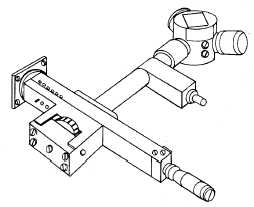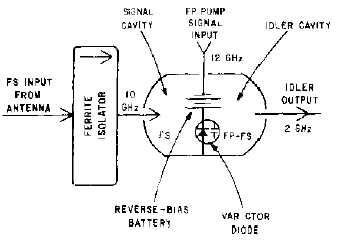2-50
Figure 2-46.—Parametric amplifier.
PARAMETRIC FREQUENCY CONVERTERS.—Parametric frequency converters, using
varactors, are of three basic types. The UPPER-SIDEBAND PARAMETRIC UP-CONVERTER
produces an output frequency that is the SUM of the input frequency and the pump frequency. The
LOWER-SIDEBAND PARAMETRIC DOWN-CONVERTER produces an output frequency that is the
DIFFERENCE between the pump frequency and the input frequency. The DOUBLE-SIDEBAND
PARAMETRIC UP-CONVERTER produces an output in which both the SUM and the DIFFERENCE of
the pump and input frequencies are available.
Parametric frequency converters are very similar to parametric amplifiers in both construction and
operation. Figure 2-47 is a functional diagram of a parametric down-converter.
The parametric frequency converter operates in the same manner as the parametric amplifier except
that the sideband frequencies are not reapplied to the varactor. Therefore, the output is one or both of the
sideband frequencies and is not the same as the input frequency. The output frequency is determined by
the cavity used as an output. For example, the idler cavity in figure 2-47 could be replaced by a cavity that
is resonant at the upper-sideband frequency (22 gigahertz) to produce an upper-sideband parametric
up-converter. Since input and output signals are at different frequencies, the parametric frequency
converter does not require a ferrite circulator. However, a ferrite isolator is used to isolate the converter
from changes in source impedance.
Figure 2-47.—Lower-sideband parametric down-converter.



